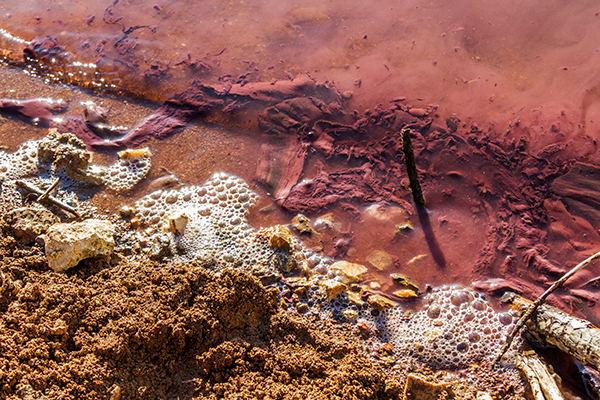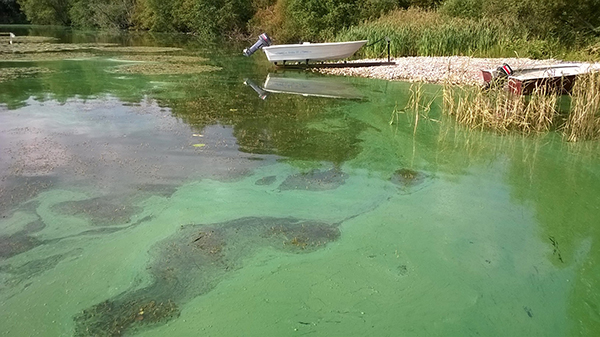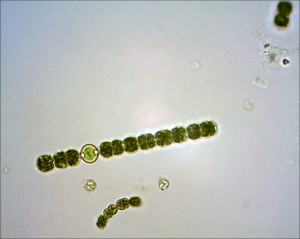Cyanobacteria, often called blue-green algae, can cause serious health problems. Treating water containing cyanobacteria with hydrogen peroxide is a new method being studied at Åbo Akademi University.
Text: Nicklas Hägen
The best and most sustainable way of handling cyanobacteria is to avert their mass occurrence. This is done by preventing the eutrophication of aquatic systems which is caused by the presence of nutrients, such as phosphates as a result of human activities such as farming.
Despite efficient sewage treatment works however, there will always be an outflow containing a certain amount of nutrients. Therefore it is necessary to be prepared for quickly treating cyanobacteria when they start to bloom. Such a method for the quick treatment of cyanobacteria is now being sought at Åbo Akademi University by repeating an experiment which was earlier conducted at the Dutch University of Amsterdam, ARCADIS Nederland and Waterschap Hunze en Aa’s. The results so far are promising.
The method consists of treating the water with hydrogen peroxide. “We want to find out whether the method works here in our waters. To begin with, we conduct tests in vitro – in a lab environment on land”, says Jussi Meriluoto, docent in biochemistry at Åbo Akademi University.
The water used in the experiment comes from Lake Köyliö. In addition experiments are carried out with Serbian water in cooperation with a research group from the University of Novi Sad, led by Professor Zorica Svir?ev.
“Some analyses still remain to be done, but the results seem positive. We also have new data on which amounts are optimal,” says Svir?ev.
The method leaves no traces
Treating water containing cyanobacteria is not a new idea. Previous attempts to suppress the growth of cyanobacteria have been done by mixing copper sulphate into the water. However, this method is not without problems, since while eliminating the cyanobacteria, copper sulphate also harms many other organisms. Moreover, the method results in the accumulation of copper in the environment.
The photosynthesis of cyanobacteria seems more vulnerable to hydrogen peroxide than that of other organisms, so treatment using peroxide is relatively safe for the environment.
“A positive feature of hydrogen peroxide is that it consists of hydrogen and oxygen, substances which exist in water as it is. When hydrogen peroxide is degraded, water and oxygen is formed, and no foreign substances remain,” Svir?ev explains.
In the Dutch experiment hydrogen peroxide was added to a lake with a so-called ‘water harrow’, which disseminates the peroxide below the surface. The amounts needed and the exact timing of the treatment for best results are details that are currently being investigated.
“The crucial thing is to nip the blooming in the bud and add hydrogen peroxide at an early stage. There is a constant competition between species and the aim is to make life unbearable for the cyanobacteria so that other species can beat them,” says Meriluoto.
If the cyanobacteria are removed, what is the risk that one problem is simply replaced with another?
“Something, such as vegetable plankton, will thrive and the rest of the vegetation in the lake will use the nutrition available there, just as the cyanobacteria do. But cyanobacteria produce poison, they are the ‘bad guys’ in water,” Meriluoto explains.
“Another alga might perhaps start utilising the nutrients, but there is hardly anything that can cause the same extent of problems as the cyanobacteria. Since they are bacteria, they grow faster than algae. And things that grow fast are almost always problematic,” says Svir?ev.
In places the Baltic Sea suffers from cyanobacteria blooms during the summers. Those who hope that hydrogen peroxide will finally provide a solution to the problem will, nevertheless, be disappointed. Treatment with peroxide is effective only in lakes.
“In the cases of such large bodies of water as the Baltic, we can do nothing but admit that the problem is outside of human control, at least when it comes to quick treatment methods. The damage has taken place over many years in the Baltic and it will require long-term work to repair it,” Meriluoto says.
Health risks
The presence of cyanobacteria can cause various health problems such as skin ailments and other irritations; it can also affect the respiratory organs, cause nausea and even hallucinations – in extreme cases it can lead to liver damage and even liver cancer.
Most bacteria prefer warmth and therefore the problem is more severe in the more southerly regions of Europe than Finland. Here we also usually have a good range of water sources, while drinking water in, for example, parts of Serbia, may have to be sourced from lakes. Thus cyanobacteria blooms are a very sensitive political and financial issue.
When cyanobacteria begin to bloom in the water reserves efficient water purification plants become necessary.
“In Serbia we don’t have as many sourcing alternatives as there are in Finland: neither do we have access to the same technology. There is a certain amount of worry in Serbia concerning cyanobacteria. Therefore it’s important for us to come and learn from Jussi and his colleagues about how problems with cyanobacteria are tackled here,” says Svir?ev.
The official line in Serbia is that tap water is not injurious to health.
Bacteria or algae?
Cyanobacteria have special features because of which they may be referred to as either blue-green algae or bacteria, depending on which approach one chooses.
The cell organisation of cyanobacteria is prokaryotic, like that of other bacteria; in other words, they are single-celled organisms which lack a nucleus. True algae, on the other hand, are eukaryotic. A eukaryote is an organism comprising one or several complex cells in which the genetic material is contained in a nucleus enclosed by a membrane.
However, cyanobacteria differ from most other bacteria in that, like plants, they use photosynthesis: they create energy by means of sunlight. Therefore they can also be called blue-green algae.




